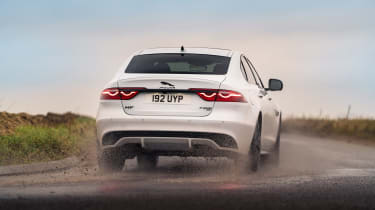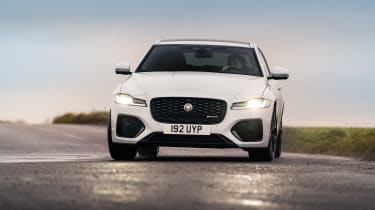Jaguar XF review – ride and handling
Back in the XF’s comfort zone, which is where you’ll be too, as the chassis is excellent and ride comfort superb across the board
You expect certain characteristics from a Jaguar when it comes to ride and handling; chiefly a controlled ride, a taught body and a sense of being part of the process. The XF doesn’t disappoint.
There are double-wishbones at the front, a multi-link set up at the rear with passive dampers fitted as standard across the saloon range. Six-cylinder engined cars can also be specified with optional configurable active dampers, first seen on the F-type.
Another component taken from the F-type is the latest EPAS steering, which has been further tuned to the XF’s dynamic make-up and, as in the F-Pace, is a system that Jaguar now claims provides better feedback and precision than the equivalent hydraulic system.
> Jaguar F Pace P400 HSE 2021 review – popular SUV refreshed, but can it take on a Macan?
With wheel sizes ranging from 18 through to 20 inches in diameter, the XF’s ride always remains on the calm and sophisticated side. The high profile tyres fitted to the smallest rims produce an unexpected level of ride comfort in today’s world of sharp edged characteristics and that doesn’t deteriorate significantly as the wheel diameter increases and the tyre profile decreases.
There’s real fluidity to the way the entire XF range dissects a road. On the standard passive dampers the body control never feels out of its depth, the chassis loading up with consistency, riding with a compliancy and changing direction with an agility of the very best in the executive car class. On the optional active dampers it’s a similar story, with improvements in terms of comfort in normal mode, although there’s no real discernable difference in Dynamic mode unless you really begin to push at the XF’s limits where it remains controlled until you breach the tyre’s grip and mild understeer takes over.
Torque vectoring is standard on all XF models, and while it doesn’t offer that on the limit the adjustability of a locking differential it’s not intrusive when it cuts in. The latest EPAS leads the class, with more natural weight than both Audi’s A6 and BMW’s 5 series, and superior feel over Mercedes’ new E class, the XF’s steering feels the most natural of all the electronic systems on the market, providing a level of feel, rate of speed and feedback unexpected from an exec saloon.
The all-wheel drive XF uses the same arrangement as the all-wheel drive F Type and F Pace; its predominantly rear wheel drive and torque is sent to the front axle if the rear loses grip. It works well in those applications, but it isn’t an inconspicuous system, whenever rear-end traction is broken as you can really sense the torque being sent to the front. However, being able to feel this process in action only makes the Jag more interesting and involving to drive.
Sportbrake models are identical in setup to the saloon save for a standard-fit self-levelling rear axle that uses air springs rather than coil springs. While the change in hardware is noticeable in the form of slightly woolier feedback, the ride quality is certainly no worse, if not any better. What this does mean is that even with the fattest Saint Bernard in the boot, the XF will stay level and contained.





